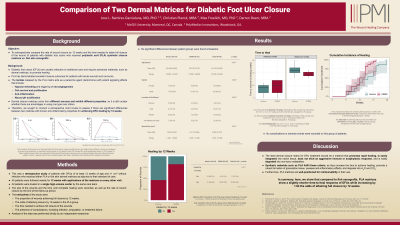Clinical Research
(CR-052) Comparison of two dermal matrices for diabetic foot ulcer closure
Friday, April 28, 2023
7:15 PM - 8:30 PM East Coast USA Time

Christian Planck, CEO; Max Froehlich, MD; Darren Doerr, MBA
Introduction: Diabetic foot ulcers (DFUs) are usually refractive to traditional care and require advanced materials, such as dermal matrices, to promote healing. These matrices come from different sources and exhibit different properties, so it is still unclear whether there are advantages in using one type over others. Here, we conducted a chart review of patients with DFUs who received a polylactic acid (PLA) synthetic matrix vs. those who received a fish skin xenograft and compared the rate of wound closure by 12 weeks and the time needed to attain full closure of the wound.
Methods: This was a retrospective study of patients with DFUs of at least 12 weeks of age and >1 cm2 without infection who received either PLA or fish skin dermal matrices as adjuncts to their standard of care. All patients were followed weekly for 12 weeks with applications of the matrices on every visit. The size of the wounds and the time until complete healing was recorded, as well as the rate of wound closure by the end of the follow-up period.
Results: Twenty-two patients received PLA matrices and 24 fish skin xenografts. Baseline data, including clinical characteristics, wound size, and its location was similar between groups. For the healed wounds, the mean time to attain full closure was 9.5 ± 2.3 vs. 8.7 ± 2.6 weeks in the PLA vs. Xenograft groups (p = 0.347). However, only 4 patients (18%) in the PLA group did not achieve complete healing by 12 weeks, compared to 13 (54%) in the xenograft group (p = 0.011).
Discussion: The ideal dermal matrix for DFU treatment should be a material that promotes rapid healing, is easily integrated into native tissue, does not elicit an aggressive immune or anaphylactic response, and is easily degraded. Synthetic materials such as PLA fulfill these criteria and are well-positioned for reimbursability in their use. Here, we show that compared to fish xenografts, which is a responsibly sourced novel material that is gaining acceptance as a dermal substitute, PLA matrices achieve a similar time-to-heal response while increasing the odds of attaining full closure by 12 weeks.
Methods: This was a retrospective study of patients with DFUs of at least 12 weeks of age and >1 cm2 without infection who received either PLA or fish skin dermal matrices as adjuncts to their standard of care. All patients were followed weekly for 12 weeks with applications of the matrices on every visit. The size of the wounds and the time until complete healing was recorded, as well as the rate of wound closure by the end of the follow-up period.
Results: Twenty-two patients received PLA matrices and 24 fish skin xenografts. Baseline data, including clinical characteristics, wound size, and its location was similar between groups. For the healed wounds, the mean time to attain full closure was 9.5 ± 2.3 vs. 8.7 ± 2.6 weeks in the PLA vs. Xenograft groups (p = 0.347). However, only 4 patients (18%) in the PLA group did not achieve complete healing by 12 weeks, compared to 13 (54%) in the xenograft group (p = 0.011).
Discussion: The ideal dermal matrix for DFU treatment should be a material that promotes rapid healing, is easily integrated into native tissue, does not elicit an aggressive immune or anaphylactic response, and is easily degraded. Synthetic materials such as PLA fulfill these criteria and are well-positioned for reimbursability in their use. Here, we show that compared to fish xenografts, which is a responsibly sourced novel material that is gaining acceptance as a dermal substitute, PLA matrices achieve a similar time-to-heal response while increasing the odds of attaining full closure by 12 weeks.

.png)